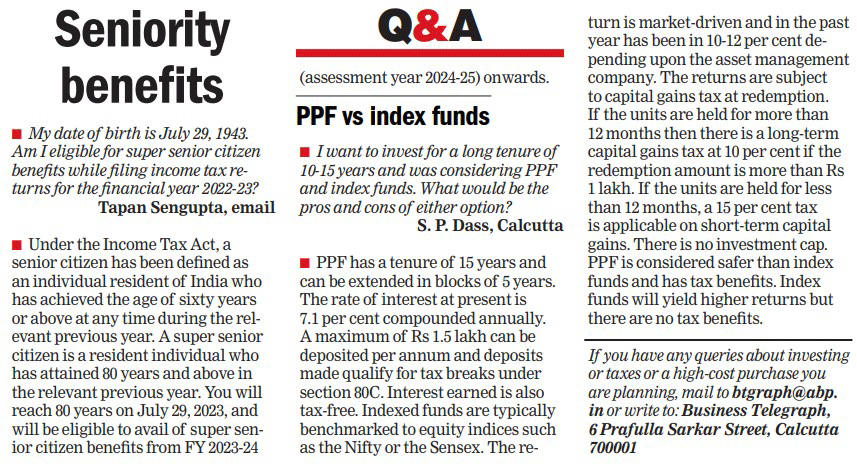The New Year is likely to bring a new set of challenges for investors, especially those who are about to end 2022 with an asset allocation that is quite different from the one they had started out with at the beginning of the calendar year. Indeed, rebalancing of assets will be a major task for a large section of the investor fraternity in the days to come.
The reasons for such skewed allocation patterns are not far to see. Many have piled their portfolios with new exposure to equity, while debt has been relegated to the backwaters. Gold, the other key asset class, has also lost some of the ground it had gained last year.
In short, the average allocator is probably a bit too high on stocks, rather low on fixed-income and somewhat neutral about the yellow metal at this juncture.
Such patterns may have to be rectified as these appear too divergent — too far removed from ideal or desired levels of allocation. Investors, both big and small, are usually advised to take corrective steps so as to rebalance their holdings. Rebalancing exercises, some suggest, may be conducted at least once a year. However, opinions vary on this front; there are no hard and fast rules for everybody to follow.
The early days of a new year will present a perfect opportunity for rebalancing. The latter, however, should be done in keeping with present market trends. As for the two principal holdings — fixed-income and stocks — the current circumstances are quite dynamic.
Fixed-income is now faced with considerable interest rate risk. The central bank has shifted stance in favour of a less accommodative policy. The banking regulator has changed the repo rate, its most important tool. The fight against inflation will require the authorities to implement a few strong measures.
As for equity, the stock market remains markedly uncertain. While indices are advancing, not all sectors are participating in the trend. Indeed, a few key segments — information technology, for instance — has generally remained subdued. Infotech companies constitute a significant part of the overall market. Its non-participation throws up a volley of questions, and the average fund investor is none the wiser.
Major issues
How should the average participant rebalance his holdings? A few key issues are worth remembering here.
One, rebalancing may necessitate some drastic changes in the existing allocation pattern.
Two, this may imply offloading of certain assets in favour of others.
Three, offloading (in practical terms, sale or redemption) may invite charges and fees. And, where capital gains are being recorded, taxes as well.
Taxes, incidentally, are very much a hot button for investors. Equity and debt have their specific norms when it comes to taxation of gains. So investors should keep themselves well informed on this front.
Sundry fees and charges are all part of an investor’s transaction costs. Rebalancing may well lead to redemptions, switches, transfers and the like. A few ongoing investment plans may have to be altered in order to introduce the desired changes. So, in sum, transaction costs will be incurred. Ergo, this will be a serious matter for the ordinary participant.
New Year Resolutions
Whether you are rebalancing immediately or not, this is just the right time for your New Year Resolutions. I have a short list — just three points — to offer. Here goes.
⚫ At all times, you must ensure safety of capital
⚫ No compromise on liquidity can be permitted
⚫ Investments must beat inflation in a sustained way
I will discuss a few related matters to highlight these points. To begin, safety of capital must be accorded the highest priority. No investor will want his principal (the amount he invested first) to lose its shine. Therefore, rebalancing efforts must not jeopardise this ideal.
Ditto for liquidity, the other prime requirement for investors. A high-stakes portfolio can sometimes ignore this aspect. Mutual funds are easy to understand and acquire. There should be no instance where an investor has remained stuck — unless there are specific instances of being otherwise. An investor should be completely free to pull out of a fund and take the proceeds elsewhere.
The tricky bit concerns inflation, which we must all be concerned about. The last communication from the banking authorities mentioned a slight decline in consumer price inflation. The latest inflation scenario, however, may not be sustained as the global markets (and surely the Indian market too) must still grapple with high commodity prices. The latter have triggered a spiral in input costs almost everywhere.
Endgame
The last word in this Monday’s piece comes to you in the manner and style of a single term — diversification. Yes, a portfolio must stay sufficiently diversified even when it is rebalanced. This, in fact, is a responsibility that the investor concerned must bear.
In the practical world, diversification is often impaired when various tweakings are done. A set of equity holdings, for instance, may lose its essential and in-built variety because of rebalancing. That will not have a positive impact on returns in the long run.
It is for the investor to work out the finer aspects of his diversification. My recommendation is simple: keep your money engaged in all kinds of assets, assuming your risk profile permits such allocation.
Assign higher weightage to equity, that is how returns are likely to take a superior turn. Yet do not bypass fixed-income and commodities.
Consider bonds, debentures, deposits and gold. These have an independent appeal of their own. In this day and age, when volatility is nearly all-encompassing, no investor can afford to ignore these completely. A new balance
The writer is director of Wishlist Capital Advisors











